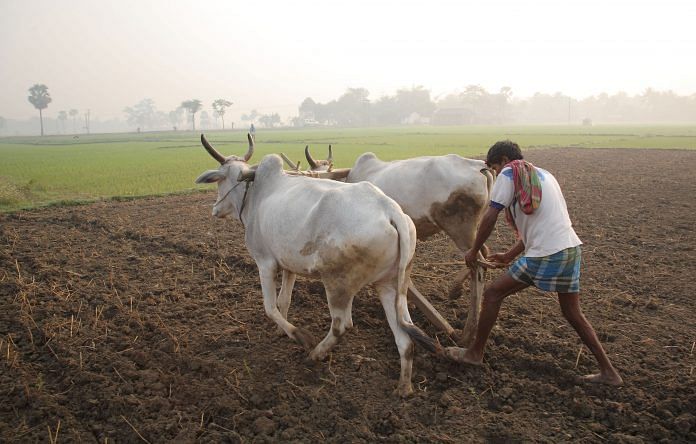The last 3 years have seen the worsening of agrarian crisis. On an average, agricultural GDP has grown at just 2.5 per cent.
I am no economist, nor a soothsayer. But you don’t have to be one to predict how this coming Budget will be presented to the nation. When finance minister Arun Jaitley gets up to present the Union Budget, it’s bound to be one dedicated to the Indian farmers.
As the Prime Minister steps out of Parliament, he will no doubt declare this to be his commitment to rural India and its farmers (nothing he does is less than historic). TV anchors and commentators will call it populist. A mild grudge from Sensex wallahs will serve to reinforce the impression that the Budget has indeed been dedicated to the alleviating the agrarian crisis.
The last three years have seen the worsening of the agrarian crisis. During this period, on an average, agricultural GDP has grown at just 2.5 per cent (Economic Survey 2017-18). Two years of consecutive drought followed by a crash in prices have bought the farmers to a brink. The last six months have witnessed a series of farmer protests across Maharashtra, Madhya Pradesh, Rajasthan, Punjab and Chhatisgarh.
Protesting farmers came together under the umbrella of the All India Kisan Sangarsh Coordination Committee to organise an unprecedented Kisan Mukti Sansad on 20 and 21 November last year. In case the message was not clear, the election results from Gujarat definitely brought it home: farmers are angry, and something needs to be done right away.
The real question is not what would be the headline of the Budget, but what would be the substance behind the headline. You need to ask yourself: Will it be all platitudes and little substance? Or is it one more mirage among the many that Indian farmers have witnessed?
In order to answer this, you need to focus on one thing: What exactly would the government announce to enhance the income of the farmers and ensure remunerative prices?
Despite the government announcing a minimum support price (MSP) twice a year, only six per cent of farmers are covered under it while a majority are compelled to sell their crops at a price that is even lower than the MSP. Because of the prices falling below the MSP, farmers suffered a loss of Rs 32,000 crore in the Kharif season this year. Even those who sell their crops at the MSP suffer losses as the present MSPs offer no margin.
Modi has reneged upon his poll promise of ensuring cost plus 50 per cent margin to the farmers. The coming Budget is the last opportunity for the Modi government to redeem itself.
News reports suggest two possible announcements that the finance minister may make. Either the central government will adapt Madhya Pradesh’s Bhavantar Bhugtan Yojana to the rest of the country, or it will announce some version of the Market Assurance Scheme (MAS) under some grand label, ‘Pradhan Mantri Kisan Samarthan Yojana’ or some such.
Under the MAS, the government will be able to procure crops other than wheat and paddy, and whenever the price of any crop falls below the government declared MSP, the government would intervene to ensure that the farmers do not suffer losses. But the real question is: Which government pays for this scheme? A few months ago, the central government had sent a draft of this scheme to the states, according to which the Centre would bear only 30 per cent of the cost of this scheme, while the other 70 per cent would have to be borne by the state governments. But the coffers of most of the state governments are empty and they cannot afford such a scheme. Even if implemented, this scheme does not extend to fruits, vegetables, or dairy products, as no MSP is declared for them.
The basic idea of the Bhavantar Bhugtaan Yojana (deficit payment scheme) is that if the farmer sells his products at a rate lower than the MSP, the government will compensate the deficit. The trouble is that in Madhya Pradesh, this scheme benefited middlemen and traders rather than the farmers. As soon as the scheme came into operation, traders colluded to bring prices down. Predictably, the prices went up the day this scheme was closed. Besides, the cumbersome paperwork for registration ensured that only one-third of the farmers were eligible for this scheme. Add to this the fact that there was a production ceiling per hectare, sometimes lower than the average yield of the crop.
All this meant a double whammy for the farmers: they received lower than normal market prices and there was neither adequate nor timely deficit payment. The traders and mill owners laughed their way to the bank. A replication of this scheme at the national level could kill this good idea and be a recipe for disaster.
So what should the finance minister do if he is serious about farmers’ income?
First, he should announce, in keeping with his own party’s election manifesto, that the MSP will be at least 50 per cent above the cost of production (C2 as per the language of CACP). The calculation of cost itself must be revised as per the recommendations of the Ramesh Chand Committee.
Second, MSP should cover all farm products including fruits, vegetables, forest produce, and dairy products.
Third, the government procurement mechanism must be expanded by setting up at least one purchase centre in every block.
Fourth, the cost of this scheme must be borne by the central government.
Fifth, bidding in mandis must not begin at a rate lower than MSP and losses to traders, if any, should be compensated by the government.
And sixth, the import-export policy should be in sync with the requirements of the farmers — free export, except in cases of serious shortage.
All this would require money. Will the FM put his money where his mouth is?
Yogendra Yadav is national president of Swaraj India.






